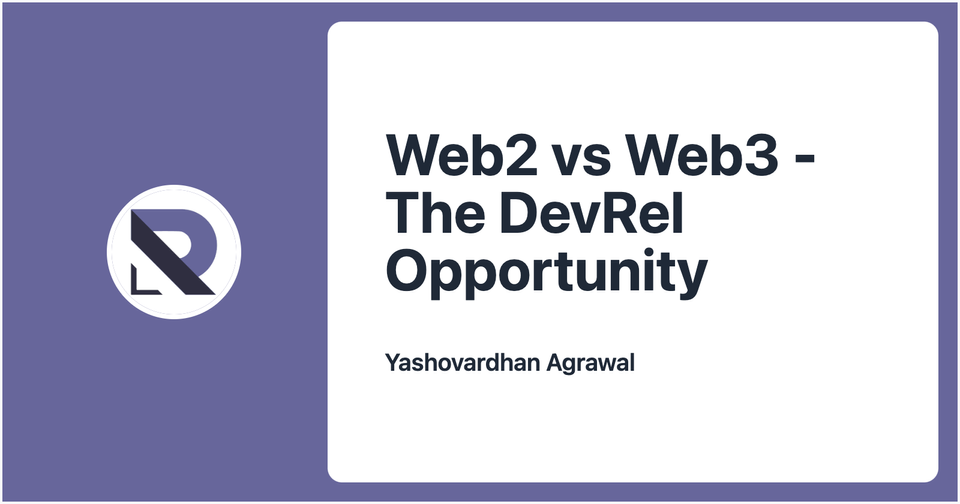Web2 vs Web3 - The DevRel Opportunity

This Valentine’s Day marks not only my three years in the Web3 space. To celebrate this milestone, I’m publishing a series of blogs reflecting on my journey as a Developer Relations (DevRel) professional in Web3. Through this series, I’ll share my takeaways, major learnings, and everything I’ve encountered along the way.
Falling for Web3: From Crypto Pessimist to Believer
Coming from a Web2 background, I was initially skeptical about crypto and its promises, but curiosity led me to explore the Web3 space. The idea of decentralization quickly fascinated me. As a DevRel professional, I learned a critical lesson early on: you can crack interviews for any company, but if you’re not genuinely passionate about the product, building and nurturing a community becomes nearly impossible.
This realization drew me to Web3Auth, whose mission of bridging Web2 and Web3 logins resonated deeply with me. It solved a problem I had personally faced, making wallets and dApps accessible even to non-technical users through simple Google login integration.
The Cultural Shock of Web3
Entering the Web3 ecosystem was nothing short of a cultural shock. At my first hackathon, ETHDenver, people queued for blocks to attend a conference. Inside, every corner seemed to have its own cult, passionately advocating why their technology was revolutionary. I particularly remember watching people cry happy tears when a Layer 2 project was launching something that day.
This was starkly different from what I had seen in Web2 conferences, where companies solved problems but didn’t inspire such fervent devotion. This cultural difference got me thinking about why DevRel is more influential in Web3 than in Web2:
- Community is Core in Web3: In Web2, communities are an afterthought, products are built first, and communities form around them. In Web3, it’s often the opposite, the community drives product development.
- Communities First, Companies Later: Many Web3 companies start as communities before evolving into structured organizations. This is why DAOs became so popular.
The Dark Side of Early-Stage Web3 Communities
While these aspects were exciting, my subsequent experiences revealed some challenges unique to Web3 communities:
- VC-Driven Numbers Game: The influx of venture capital funding turned many projects into number-driven exercises rather than innovation-driven endeavors.
- Token-Centric Communities: Some communities formed around token shilling rather than genuine contributions to the ecosystem.
- Surface-Level Engagement: People saying “GM” every day on the discord server weren’t necessarily part of the real community—those building and contributing were. Projects tend to ignore that fact to keep up with the numbers game.
- Grant Overload: Generous grant programs incentivized developers to build quickly for rewards but often led to abandoned projects and developers hopping ecosystems for better rewards.
- Money Over Innovation: As funding dried up during bear markets, many ecosystems collapsed due to a lack of sustainable innovation and applications.
These issues especially created challenges for junior developers who were drawn to the shiny allure of free food, drinks, and quick incentives without understanding the long-term implications.
The Maturity of Web3 Communities
Over the last three years, and especially during the recent bear market, the ecosystem has matured significantly. Developers and communities have shifted their focus back to building real use cases rather than chasing quick wins or token prices.
This evolution is evident in how communities are now being approached:
- There is less emphasis on superficial engagement and more focus on meaningful contributions.
- Developers are increasingly prioritizing sustainable innovation over short-term incentives.
- Communities are becoming more resilient and value-driven.
Throughout the evolvement of the ecosystem, one thing remained constant: DevRel in Web3 is still incredibly influential. This is because it sits at the intersection of community building and product development. If done right, with an emphasis on genuine engagement and long-term value creation, DevRel professionals can play a pivotal role in shaping both products and communities with real-world impact.
Key Takeaways for Aspiring DevRels in Web3
- Passion Drives Influence: Choose a product you’re genuinely passionate about—it’s impossible to inspire others if you’re not inspired yourself.
- Community Comes First: In Web3, your community isn’t just your audience; they’re your collaborators and co-creators.
- Focus on Builders: Real communities are made up of contributors who build and innovate, not those chasing quick incentives or superficial engagement.
- Adapt to Ecosystem Shifts: The space evolves rapidly; staying adaptable is key to remaining relevant as a DevRel professional.
- Be Prepared for Challenges: While the passion in this space is unparalleled, navigating its complexities requires resilience and focus.
Web3 has come a long way since I joined three years ago, and so have I as a DevRel professional. The passion that drew me into this ecosystem still burns bright, but it is tempered by lessons learned along the way. As we continue building towards a decentralized future, DevRels have an unparalleled opportunity to empower developers while shaping products that truly matter.

